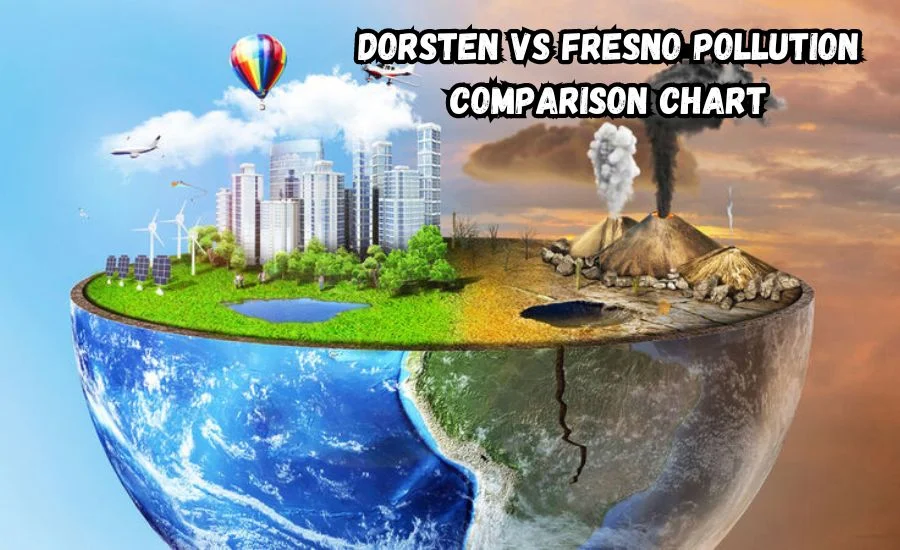Dorsten, a town in Germany, and Fresno, a city in California, have distinct environmental and industrial landscapes, leading to differences in pollution levels. Here’s a comprehensive comparison chart focusing on air quality, pollution sources, and environmental policies:
| Factor | Dorsten (Germany) | Fresno (California, USA) |
|---|---|---|
| Air Quality Index (AQI) | Generally low to moderate, averaging around 40-60 AQI | Frequently higher, ranging from 70-150 AQI, and worse during wildfire season |
| Main Pollutants | Nitrogen dioxide (NO2) from vehicular emissions, PM2.5 | Ozone (O3), PM2.5 from agriculture, traffic, and wildfires |
| Population Density | Lower population density leads to fewer emissions | Higher population density, contributes to greater emissions |
| Industrial Emissions | Limited heavy industry, moderate emissions | High due to agricultural industry, oil production, and energy use |
| Agricultural Impact | Some agricultural emissions but minimal | Significant emissions from pesticides and fertilizers |
| Vehicle Emissions | Strict EU regulations on vehicle emissions | High vehicle emissions, though regulations are tightening |
| Green Spaces and Trees | Extensive parks and forests help to absorb CO2 | Less green space, though efforts are underway to increase urban forestry |
| Government Regulations | Strong environmental laws and enforcement (EU) | Mixed environmental policies, often impacted by federal-state conflicts |
| Wildfire Impact | Minimal or nonexistent | Major pollution source, especially in late summer/fall |
| Public Transportation | Well-developed, reducing reliance on personal vehicles | Limited public transport, high reliance on personal cars |
| Renewable Energy Initiatives | Strong push for renewable energy like wind and solar | Growing use of solar, but heavy dependence on fossil fuels |
1. Air Quality
Air quality in Dorsten is generally better than in Fresno. Dorsten benefits from stricter environmental regulations in Germany and the European Union, as well as a smaller population and lower industrial activity. Fresno, in contrast, suffers from worse air quality, particularly during wildfire season, due to a combination of vehicular emissions, agriculture, and seasonal fires.
- Dorsten’s AQI: Ranges from 40 to 60, which is considered moderate and safe for most activities.
- Fresno’s AQI: Often exceeds 100 during wildfire season and summer months, with periods reaching unhealthy levels due to ozone and particulate matter (PM2.5).
2. Pollution Sources
In Dorsten, the main sources of pollution are vehicular emissions and some industrial activities. However, strict regulations have kept the pollution levels under control. In Fresno, agriculture, traffic, and wildfires are significant contributors to the area’s high levels of ozone and fine particulate matter (PM2.5). The use of pesticides and fertilizers further exacerbates pollution in Fresno.
3. Vehicle Emissions
Both cities deal with vehicle emissions, but the situation in Fresno is more severe due to its larger population and reliance on personal vehicles. While Dorsten follows the European Union’s stringent emission standards, Fresno is still struggling with high emissions, despite improving air quality regulations in California.
- Dorsten: The city’s vehicle emissions are managed through comprehensive public transportation options and strict emission regulations.
- Fresno: The city has fewer public transport options, and vehicle emissions remain a significant problem.
4. Agricultural and Industrial Contributions
Dorsten has limited agricultural impact, while Fresno, located in California’s agricultural heartland, produces substantial emissions from farming activities. Dust from farmland, diesel-powered machinery, and the burning of agricultural waste all contribute to Fresno’s pollution. Additionally, oil production around Fresno adds to air quality concerns.
- Dorsten: Agriculture plays a minor role, with fewer pollutants coming from farming activities.
- Fresno: Agriculture is a major source of pollution, particularly PM2.5, due to dust and chemical use.
5. Environmental Regulations
Germany and the EU have some of the strictest environmental policies globally, which Dorsten benefits from. These include stringent vehicle emission standards, strong industrial pollution control, and the promotion of renewable energy. In contrast, Fresno falls under U.S. federal and California state regulations. While California has implemented progressive air quality standards, the scale of pollution sources (particularly agriculture and transportation) makes it difficult to maintain lower pollution levels consistently.
- Dorsten: Strict environmental regulations, strong enforcement, and focus on sustainability.
- Fresno: Mixed enforcement of pollution regulations, with agriculture often exempt from certain restrictions.
6. Green Spaces and Urban Planning
Dorsten has a large number of parks, forests, and green spaces that help absorb CO2 and improve air quality. Fresno, on the other hand, is densely urbanized, and while there is an ongoing effort to plant more trees and develop parks, it currently lacks the level of green space that could significantly improve air quality. Green initiatives are growing in both cities, with increasing attention to planting trees and creating urban forests.
- Dorsten: Ample green spaces that aid in reducing pollution.
- Fresno: Fewer green areas, though there are ongoing efforts to increase urban forestry.
7. Impact of Wildfires
One of the most significant pollution differences between Dorsten and Fresno is the presence of wildfires. While wildfires are virtually nonexistent in Dorsten, they are a recurring problem in California, and Fresno often experiences poor air quality due to smoke from fires burning in nearby areas. Wildfires release massive amounts of particulate matter and harmful chemicals into the air, making Fresno’s air quality considerably worse, especially during late summer and fall.
- Dorsten: No significant wildfire impact.
- Fresno: Wildfires are a major source of seasonal pollution, with severe spikes in particulate matter.
8. Renewable Energy and Sustainability Efforts
Both cities are making strides toward sustainability, but Dorsten is ahead in terms of renewable energy adoption. Germany’s push for renewable energy—especially wind and solar—has positively impacted air quality. Fresno is also moving in that direction, with increasing use of solar energy, though its reliance on fossil fuels remains high.
- Dorsten: Significant investment in renewable energy, including wind and solar power.
- Fresno: Growing solar energy sector, but still heavily dependent on traditional energy sources.
Conclusion:
When comparing Dorsten and Fresno in terms of pollution, Dorsten enjoys better air quality and stricter environmental regulations. Fresno, despite making progress in renewable energy and green initiatives, struggles with higher pollution levels due to agriculture, transportation, and seasonal wildfires. Both cities continue to work toward improving their environmental conditions, with a focus on sustainability and reducing emissions.




